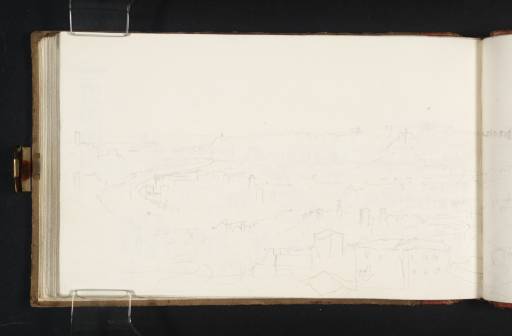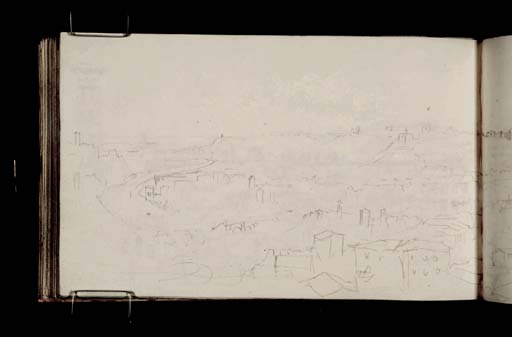Joseph Mallord William Turner Part of Panoramic View of Rome from the Tower of the Capitol: The Aventine to the Janiculum 1819
Image 1 of 2
Joseph Mallord William Turner,
Part of Panoramic View of Rome from the Tower of the Capitol: The Aventine to the Janiculum
1819
Joseph Mallord William Turner 1775–1851
Folio 75 Verso:
Part of Panoramic View of Rome from the Tower of the Capitol: The Aventine to the Janiculum 1819
D16293
Turner Bequest CLXXXVIII 74 a
Turner Bequest CLXXXVIII 74 a
Pencil on white wove paper, 114 x 189 mm
Inscribed by the artist in pencil ‘River’ centre right-hand edge
Accepted by the nation as part of the Turner Bequest 1856
References
1909
A.J. Finberg, A Complete Inventory of the Drawings of the Turner Bequest, London 1909, vol.I, p.560, as ‘General view of Rome’.
1984
Cecilia Powell, ‘Turner on Classic Ground: His Visits to Central and Southern Italy and Related Paintings and Drawings’, unpublished Ph.D thesis, Courtauld Institute of Art, University of London 1984, pp.223, 427, reproduced fig.146, as ‘Panoramic view from the tower of the Capitol (a): the Aventine to St Peter’s’.
1987
Cecilia Powell, Turner in the South: Rome, Naples, Florence, New Haven and London 1987, p.106 note 11.
This sketch is part of a view of Rome encompassing the Aventine Hill in the south to St Peter’s in the north. As Cecilia Powell first identified, the prospect is taken from the tower of the Senatorial Palace on the Capitoline Hill, one of the most popular vantage points in the city.1 In his diary, the poet Thomas Moore recorded that Turner was seen at the top of the tower in 1819 by a friend, one Colonel Camac.2 The latter provoked Turner’s displeasure when he seized the artist’s umbrella to shield the Princess of Denmark from the wind, much to her delight and Turner’s annoyance.3 It is likely that this episode interrupted Turner’s attempts to make a complete record of the 360-degree view of the city, as seen here, spread across four double-page spreads, see folios 74 verso–79 (D16293–D16300; Turner Bequest CLXXXVIII 74a–78).
Turner’s treatment of the view reflects the vogue for urban panoramas, a popular form of public entertainment which was at its height in the late eighteenth and early nineteenth centuries. The invention of Robert Barker (1739–1806) who patented the design in 1787, panoramas were vast painted images which surrounded the viewer, creating the illusion of actually being in front of the subject.4 The scenes, exhibited in purpose-built rotundas, could be semi-circular, depicting a view of 180 degrees, or 360 degrees, representing a complete view in the round.5 As Barker wrote in his patent, the artist must first find a situation from which he can see ‘an entire view ... as it appears to an observer turning quite round’ and from there ‘delineate correctly and connectedly every object which presents itself to his view as he turns’.6 As well as views of cities and landscapes, popular subjects included historic and contemporary themes, such as battles or other topical events. The first panorama in London was built in Leicester Square but such was the public enthusiasm for them that others followed in the Strand, Regents Park and Spring Gardens. At the Leicester Square panorama alone, 126 views were exhibited during its lifetime, between 1793–1863.7
Although there is no record after the fact, it is extremely likely that Turner would have visited a panorama at some point,8 and a number of views featuring Rome date from the period of his two visits to the city.9 In particular, he had the opportunity to see two 360-degree panoramas exhibited in the Strand which showcased the view from the Tower of the Capitol: the first by Ramsay Richard Reingale in 1802; and the second by Henry Aston Barker and John Burford in 1818.10 According to the published programme for the latter, the view from the Capitoline was taken from the second storey of the tower of the senatorial palace:
from hence we have the most magnificent view of this celebrated city; nor does any other situation afford so general and interesting a prospect of the antiquities and modern city of Rome. We see almost the whole boundary of the ancient walls; the seven hills (not including the Pincian); the Campus Martius; the Roman forum; the river; the Campagna; and an extensive range of the Apennines.11
Turner’s series of drawings covers precisely the same scope and whether consciously, or unconsciously, the artist’s approach shares a number of technical similarities to the exhibited panoramas, for example, the illusive manipulation of line and perspective so that features appear straight and in proportion, see folio 77 verso (D16297; Turner Bequest CLXXXVIII 76a), and the inclusion of buildings in the immediate foreground such as the receding steps at the top of Capitoline and the façade of the Church of Santa Maria in Aracoeli, see folio 79 (D16300; Turner Bequest 78). In appearance, the style of his sketches resembles the annotated outline images published with a key in the programme pamphlets accompanying the panoramas.12 Like these explanatory illustrations, Turner has chosen not to record every single building and monument but has picked out only the most salient, leaving the interim spaces blank.
The identifiable features within this sketch include (from left to right): the Romanesque bell-tower of Sant’Alessio all’Aventino (today known as Santi Boniface e Alessio); the meandering River Tiber and the surviving arches of the Ponte Rotto; the bell-tower of Santa Cecilia in Trastevere; and, in the top left-hand corner, the Janiculum Hill with San Pietro in Montorio and the Villa Doria Pamphili. The view continues on the opposite sheet of the double-page spread, see folio 76 (D16294; Turner Bequest CLXXXVIII 75). Turner also made a similar record of the circle of vision from the summit of the Church of Santi Cosma e Damiano in the Forum, see folios 70 verso–74 (D16283–D16290; Turner Bequest CLXXXVIII 69a–73).
Nicola Moorby
January 2009
Lord John Russell (ed.), Memoirs, Journal and Correspondence of Thomas Moore, London 1853, vol.III, pp.104–5.
Ralph Hyde, ‘Turner’s Times – Panoramania: Art and Showmanship’, lecture, Tate Gallery, London, 4 June 1987, Tate Archive. TAV 686 A.
Robert Barker, ‘Repertory of Arts and Manufactures’, 1796, quoted in Greg Smith, Thomas Girtin: the Art of Watercolour, exhibition catalogue, Tate Britain, London 2002, p.189.
Powell 1984, pp.222–3. Other Italian subjects shown in London during Turner’s lifetime included views of Florence, Naples, Venice, Milan, Pompeii and the surrounding country, and a description of the interior of the Colosseum.
See R.R. Reinagle, An Explanation of the View of Rome, Taken from the Capitol: Now Exhibiting at the Panorama near the new church in the Strand, London 1802 and An Explanation of the View of Rome, taken from the Tower of the Capitol, Now Exhibiting at H.A. Barker and J. Burford’s Panorama, near the new Church in the Strand, London 1817.
How to cite
Nicola Moorby, ‘Part of Panoramic View of Rome from the Tower of the Capitol: The Aventine to the Janiculum 1819 by Joseph Mallord William Turner’, catalogue entry, January 2009, in David Blayney Brown (ed.), J.M.W. Turner: Sketchbooks, Drawings and Watercolours, Tate Research Publication, December 2012, https://www


